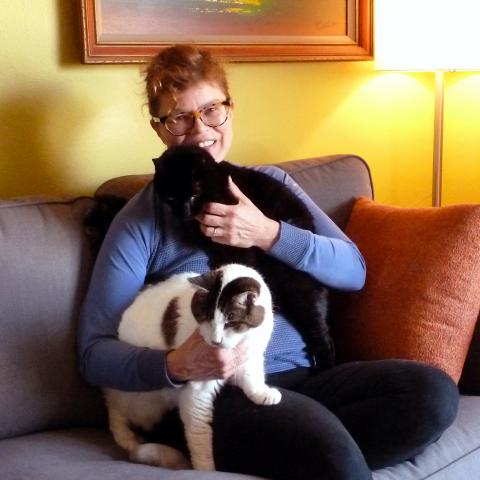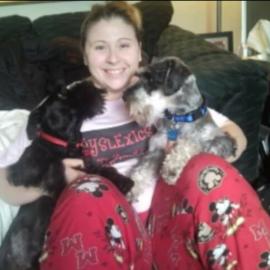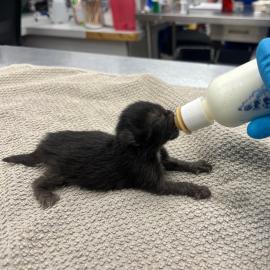Rebekah U. - October 2021 Volunteer of the Month
For Rebekah U., fostering medically needy cats feels like an easy and rewarding extension of what she’s already doing for her owned cats, and in her medical profession.
Rebekah has always had dogs since she was born. She remembers her first cat when she was 4, who just showed up and became theirs. “Pets have always been a really important part of my life,” Rebekah says. “My best friend as a kid was my cat, MeToo.
Cattery Volunteer
“In 2014, my husband, Colin, and I weren’t able to have cats due to our housing arrangements, so we wanted to try volunteering somewhere,” Rebekah says. “The first mention of MCAS we saw was from Sir Stuffington, a Snowshoe Siamese kitten with one eye, dressed as a pirate, fostered by Blazer S. We started following him on social media, and it got us interested in volunteering. So we came to a volunteer information session, signed up, and started training to work with cats.
“At first, I volunteered once a week in the cattery. It was really rewarding to match up a cat with an adopter, that was always a great feeling. We got to know the cats really well. Colin and I would even come in when we weren’t volunteering to visit with them. Then when someone came in looking for a cat, we could make recommendations based on what they needed, and match them appropriately- whether they needed a cat that was more active, or got along with other cats.
“Volunteering in the cattery has changed a lot since we first started. At first, all the kennels were the in-wall stainless steel cages that were four levels high. Every now and then, there were cats placed in the top kennels, way up high, and it would be packed full of cats. It really helped the cats and their caretakers when those kennels were replaced in 2015. Colin and I helped with the installation of the new kennels. They were a great improvement- they gave the cats more space to spread out, and to find private or elevated space. It’s easier for us to see the cats against a white background, and the kennels are quieter than the stainless cages were. The cats have a lot more room to be cats.”
Surgery Volunteer
“Shortly after starting to volunteer in the cattery, I started volunteering in surgery. Another cattery volunteer, Ray K., said MCAS was always looking for surgery volunteers, recommended it, and told me all about it. So I went in and talked with the vet techs, and started coming in one day every other week for five to six hours to help out.
“I’m an MRI tech by trade, so I have a medical background and am fascinated by surgical stuff that others might consider gross. So I already knew how to do basic things to assist, like scrubbing in and maintaining a sterile field. I’ve helped Dr. Romney hold limbs while she works sometimes. I really enjoy it and I love the staff.
“Volunteering in surgery was a great experience. Basically, I would get the animals from their kennels, bring them in, weigh them, take temperatures, and do all the prep work. I would help hold them to medicate, trim claws, shave bellies, and all that stuff. The majority of the things that I saw were routine spays and neuters, but it’s really interesting for me to see how it works, and just to be part of the process. I also understand that spay & neuter is such an important part of pet ownership and care- we need to make sure that the population numbers are managed.”
Hospice Foster Volunteer
Rebekah and Colin have been fostering cats since 2015, when they took in their first cat, Zaria, as a hospice foster. “She wasn’t expected to live more than a year, and we had her for four years,” Rebekah says.
“Zaria was in the cattery while we were volunteering, and we fell in love with her. She was a blind Siamese with chronic kidney disease. She was there for several months, and we got to know her. She wasn’t seeing any interest on the adoption floor, and several attempts to transfer her to regional adoption partners fell through due to her renal failure. She was running out of placement options, and was being evaluated. So we took her in and started fostering her in hospice. Veterinary staff estimated she would live for six months to a year. We had her for close to 4 years before she passed away in 2019. She was our first foster and only foster we had for that long.
“After Zaria, we had our cat, Rollie, whom we adopted in 2016, and he unfortunately died in 2019. He only had one functioning kidney, which unexpectedly ruptured. It broke my heart, but he was just a joy of a cat. Our other cat, Sly, is blind, has hypothyroidism, kidney disease, and diabetes. We take the hard cases. Basically, if they can be adopted, you can have them back. If they are hard to place, we’re happy to adopt them. We have another foster, Leeroy, who also has kidney disease, hyperthyroidism, a heart murmur, and arthritis. He yowls all the time, and staggers around. We love them so much, and I can’t imagine not having them around.”
Fostering Kittens
“In 2019, I was volunteering in surgery one day, and Jacque, one of the vet techs, asked if I was interested in fostering a couple of kittens with severe upper-respiratory infection (URI),” Rebekah says. “One of them had a really bad eye infection. It was really bad. His eyes were prolapsed, and his vision was unsavable. Wesley and Charlie were their names. It was a dream having them. Ever since then, we’ve fostered litters of kittens- with or without mothers. We now have a mama cat and her sole kitten living downstairs until the kitten is big enough to be spayed and put up for adoption.
Getting Fosters on the Mend
“We always go for the geriatric cats,” Rebekah says. “Between sick kittens, adult cats with medical issues or on hospice, it’s so satisfying to get them on the mend.
“I appreciate so much what the shelter does with so little, and I’m always happy to be able to help with whatever. Fostering for the last few years, we’ve focused on medically needy cats. I really enjoy helping with that because we have plenty of space at home, and time to do it. The medical portion of care is also relatively easy for me to do. Whether we’re giving medication, shots, subcutaneous fluids, or providing other care. It’s easy. We’re already doing that for our cats with medical issues.”
Rebekah’s Advice to Interested Volunteers
Rebekah’s advice to interested volunteers is to “do it! Take the step and give it a try, and you’ll find that it’s really rewarding and satisfying. No matter what capacity you’re volunteering in, whether fostering, helping with laundry, or in the cattery, you get a lot from doing it.”
“I really appreciate all the work that all of the staff and volunteers do at the shelter. It’s such an important part of the community. I’m really grateful to be a part of the process to help the animals and the community.”
Thank you, Rebekah, for your service to the pets and people of Multnomah County as a volunteer.



